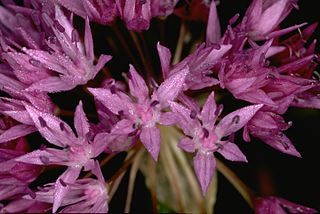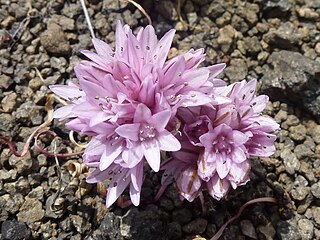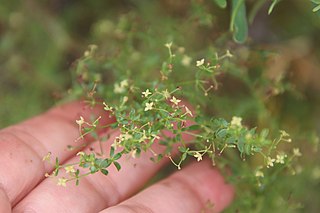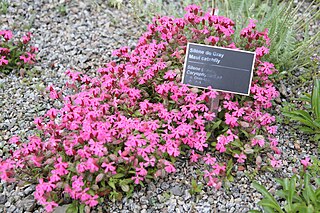
Allium validum is a species of flowering plant commonly called swamp onion, wild onion, Pacific onion, or Pacific mountain onion. It is native to the Cascade Range, to the Sierra Nevada, the Rocky Mountains, and other high-elevation regions in California, Oregon, Washington, Nevada, Idaho and British Columbia. It is a perennial herb and grows in swampy meadows at medium and high elevations.

Galium triflorum is a herbaceous plant of the family Rubiaceae. It is widespread in northern Europe, eastern Asia and North America. The plant is considered a noxious weed in New York, Pennsylvania, Vermont, New Hampshire, Connecticut and Massachusetts.

Galium mollugo, common name hedge bedstraw or false baby's breath, is a herbaceous perennial plant of the family Rubiaceae. It shares the name hedge bedstraw with the related European species, Galium album.

Allium acuminatum, also known as the tapertip onion or Hooker's onion, is a species in the genus Allium native to North America.

Allium atrorubens is a species of wild onion known by the common name dark red onion. This plant is native to the southwestern United States where it grows in the sandy soils of the Mojave Desert, the Great Basin and higher-elevation deserts in Nevada, eastern California southwestern Utah, northwestern Arizona.

Allium lemmonii is a species of wild onion known by the common name Lemmon's onion, named for botanist John Gill Lemmon (1831–1908). It is native to the western United States, at elevations of 1200–1900 m in the Great Basin of Utah, Nevada, northern and eastern California, eastern Oregon, southwestern Idaho.

Allium nevadense is a species of wild onion known by the common name Nevada onion. It is native to the western United States where it grows in sand and rocky soil at elevations of 1400–1700 m. The species is widespread in Utah, Nevada and southern Idaho, and has been reported also from southeastern California, northwestern Arizona, western and central Colorado and eastern Oregon.

Allium parvum is an American species of wild onion known by the common name small onion. It is native to the western United States where it is a common member of the flora in rocky, dry areas in mountainous areas, especially in talus at elevations of 1,200–2,800 m (3,900–9,200 ft). It is widespread in California, Nevada, Oregon and Idaho, and also reported from western Utah and from extreme southwestern Montana
Galium bolanderi is a species of flowering plant in the coffee family known by the common name Bolander's bedstraw. It is native to the mountains of California and southern Oregon. It is a resident of mountain forests and chaparral slopes.

Galium grayanum is a species of flowering plant in the coffee family known by the common name Gray's bedstraw. It is native to the high mountains of northern California, western Nevada and southwestern Oregon.
Galium matthewsii is a species of flowering plant in the coffee family known by the common names bushy bedstraw and Matthews' bedstraw. It is native to the mountains and deserts of southeastern California, and southern Nevada.

Galium porrigens is a species of flowering plant in the coffee family known by the common names graceful bedstraw and climbing bedstraw. It is native to the west coast of North America from Oregon to Baja California.
Allium punctum is a species of wild onion known by the common name dotted onion or Modoc onion. It is native to the western United States in and around the Modoc Plateau in northeastern California, northwestern Nevada, and southeastern Oregon. It is uncommon, growing in volcanic flatlands created by old lava flows.

Yolla Bolly bedstraw is a species of plant in the family Rubiaceae, native to British Columbia, northern California and southeastern Oregon, where it often grows on serpentine soils.

Galium serpenticum is a species of flowering plant in the coffee family (Rubiaceae) known by the common name intermountain bedstraw or many-flowered bedstraw.
Galium sparsiflorum is a species of flowering plant in the coffee family known by the common name Sequoia bedstraw. It is endemic to California, where it grows in shaded habitat in certain mountain ranges, including the Sierra Nevada.

Menodora spinescens is a species of flowering plant in the olive family known by the common name spiny menodora. It is native to the southwestern United States, where it grows in varied mountain, canyon, and desert habitat in California, Nevada, Utah and Arizona.

Silene grayi is a species of flowering plant in the family Caryophyllaceae known by the common name Gray's catchfly. It is native to the mountains of Oregon and northern California, including the Klamath Mountains, where it grows in chaparral, mountain forests, and the talus of high slopes in alpine climates. It has been observed to occur in a plant association with oceanspray, littleleaf silverback, and Gray's bedstraw. It is a perennial herb producing a decumbent or erect stem up to 20 or 30 centimeters long from a woody, branching caudex. The base of the plant is covered in tufts of leaves. These basal leaves are lance-shaped to nearly spoon-shaped, fleshy, and up to 4 centimeters long. Smaller, narrower leaves occur farther up the stems. Each flower has a tubular calyx of fused sepals lined with ten green or red veins and covered in glandular hairs. It is open at the tip, revealing five pink or purple petals. The petal tips and appendages are divided into narrow lobes.

Physaria lepidota, the Kane County twinpod, is a plant species endemic to Utah. It is known only from Kane, Washington, and Garfield Counties in the southern part of the state. It grows on rocky slopes and outcrops, and sometimes in disturbed areas.
Thelypodium laxiflorum, the droopflower thelypody, is a plant species native to the southwestern United States. It grows in open, rocky places on slopes and cliff faces, usually in pinyon-juniper woodlands at elevations of 4,900–10,200 feet (1,500–3,100 m). It has been reported from Utah, western Colorado, southern Nevada, northwestern Arizona, and northwestern New Mexico.















